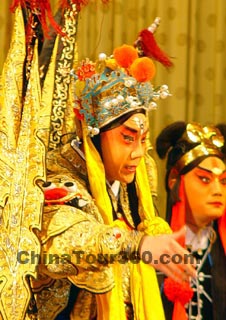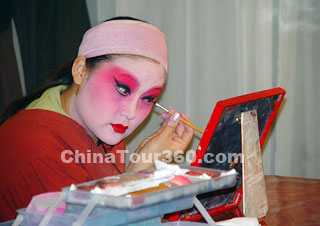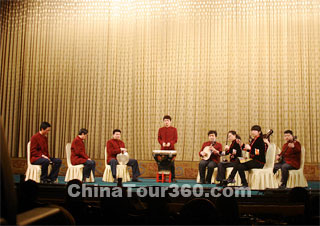 |
| A Character of Beijing Opera |
By doing away with three-dimensional stage props and complicated backdrops found in Western opera, Chinese opera conveys the idea of time and space to the audience through the acting of performers. This simple and flexible technique is called 'imagined time and space' in Chinese operatic terminology. The acting, however, is not mere imitation of movements in daily life. Instead, it has been perfected to bring out just their essentials, making them highly-stylize and rhythmic dancing movements. Such acting is described in the stage language as 'stylized formula'. In addition, there are specific costumes, facial make-ups, musical motifs and recitations to represent each character in the series of characters known as Xingtous. All this, plus imagined time and space and stylized acting, has enabled the story to rise above real life and create a strong dramatic atmosphere with distinct operatic effects.
Western ears do not readily appreciate this art, for it often seems shrilly and 'noisy'. Shrill voices pierce the air, accompanied by loud gongs, crashing cymbals, pounding drums and droning stringed instruments. The music is not intended to be melodic, as in the West, but rather used as punctuation to the performance. Chinese opera is an art of the people - enjoyed and appreciated by all across the social spectrum. In a real sense it is a folk art, comparable in many ways with the Chinese Circus. Although the music may seem very alien, the stories told are very familiar to those accustomed to Western opera: heroes battle overwhelmingly powerful foes, good versus evil, and lovers seek escape from domineering and disapproving parents.
A distinct feature is the makeup, movements, props, and colorful costumes. These features identify a character's age, sex, and personality the moment he or she enters the story. Face painting leans heavily on earlier forms of mask and make up. Facial patterns rely on exaggeration and the symbolism of color to suggest a character's attributes and personality. The painted faces become what people call 'a mirror of the soul'. Well-versed members of the audience will be able to tell instantly the personality of characters on the stage by their painted faces. Although colors sometime represent a physical attribute of a character, they are predominantly used as indicators of a character's personality. Apart from the exquisitely embroidered traditional costumes, head-dresses are a requisite. The more elaborate the head-dress, the more significant the character. Costumes are extravagant in style in order to achieve as great a theatrical effect as possible. Like the face makeup, the color codes of these costumes identify the various ranks, status, and personality of the characters.
|
|
Although sharing a common ancestry, Chinese opera boasts over 300 various distinct forms - taking their names from their places of origin. These forms are generally discernible by their use of local dialects and distinct 'melodies'. Beijing opera is considered by most to be the most refined. Also widespread are Pingju, Kunqu, Shaoxing, Henan, Sichuan, Shanxi, Huangmei, Huagu and Yangko Operas. Some minority groups in China have some local form of operas.









